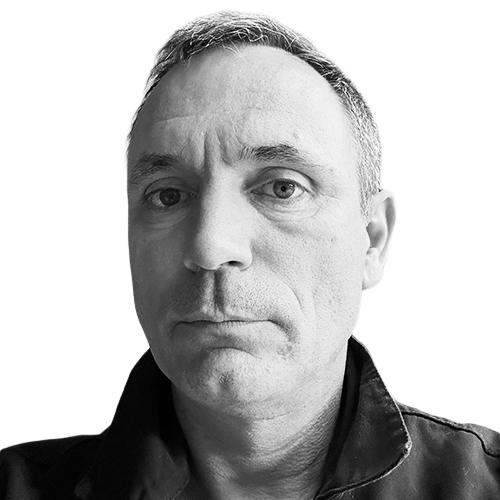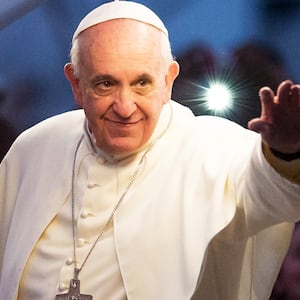Pope Francis, who died at 88 on Monday, used his last days on the planet to order up a stern dressing down to JD Vance on the White House’s attitude to migrants.
It was an entirely fitting final set piece from one of the few world leaders who had the courage—and political immunity—to stand up to and criticize, often in blistering terms, both presidencies of Donald Trump, explicitly calling his migration policies a “disgrace” and “not Christian.”
Vance met with Francis in the Vatican on Sunday. He was given Easter eggs for his children.
While that brief meeting appears to have been largely conciliatory in tone, with Vance telling Francis, “It’s good to see you in better health,” Francis’ official Easter speech later in the day seemed to rebuke the MAGA/Vance stance on immigrants and foreign aid: “How much contempt is stirred up at times towards the vulnerable, the marginalized and migrants,” Francis wrote in the address.
Sunday’s events were preceded by a less diplomatic meeting on Saturday between Vance and Francis’ number 2, Cardinal Pietro Parolin, and the Vatican’s foreign minister, Archbishop Paul Gallagher, in the Apostolic Palace.
The Holy See spoke in frank terms after that meeting, saying there had been “an exchange of opinions on the international situation, especially regarding countries affected by war, political tensions and difficult humanitarian situations, with particular attention to migrants, refugees, and prisoners.”
It called for “serene collaboration” between the White House and the Catholic Church in the United States.
A statement from Vance’s office notably did not include migration among the topics of conversation, saying the two discussed Trump’s “commitment to restoring world peace,” Bloomberg reported.
In a post reacting to Francis’ death, Vance shared his condolences with “the millions of Christians all over the world who loved him,” but stopped short of expressing a personal sense of loss. Vance added that he’d been “happy” to see Francis on Sunday and said he’d “always remember” him for a homily given at the beginning of the COVID pandemic.
That Francis dared to stand up to Donald Trump and his minions to the very end will surely cement his legacy as the anti-MAGA pope.
In February 2025, Francis responded to Trump’s plans for mass deportations of undocumented immigrants on Italian talk show Che Tempo Che Fa, saying: “If true, this will be a disgrace… This is not the way to solve things.”
It was also not his first run-in with Vance, the highest-ranking Catholic in the U.S. government, who converted to the faith in 2019.
In a February letter, Francis critiqued Vance saying, “Christian love is not a concentric expansion of interests that little by little extend to other persons and groups.”
Vance acknowledged the Pope’s criticism, calling himself a “baby Catholic” and admitting that there are “things about the faith that I don’t know.”

Undoubtedly some of the papal animus towards Trump’s immigration policies sprang from his status as the first Latin American pope, and Trump’s relentless denigration of the continent; Francis was born Jose Mario Bergoglio, in 1936, in Argentina.
Trump and Francis clashed during Trump’s first presidency, when Francis described the proposal to build a southern border wall as “not Christian.” Trump retaliated, calling Francis “disgraceful” and a “very political person.” It didn’t stop Trump making a 2017 visit to the Vatican and calling it the “honor of a lifetime.”
Few would have predicted that Francis would have ended up preaching fire and brimstone against the president of the United States when he was elected in a fractious 2013 conclave. Francis was essentially a compromise candidate whose main asset was his low profile, his love of consensus and his reputation for humility.

He took on the leadership of the Catholic Church from Benedict XVI, whose inept handling of the Catholic child-abuse scandals led him to become the first pope to resign in more than 600 years.
Pope Francis inherited a holy mess: Benedict’s disastrous papacy had left the Catholic church at war with itself, bitterly divided between traditionalists who had applauded Benedict’s scholarly, rigid interpretation of Catholic doctrine, and liberals and progressives within the Church who felt at best marginalized and at worst utterly abandoned by it—as did millions of traumatized Catholics and their families worldwide who had been affected, either directly or indirectly, by clerical abuse.
Not being Pope Benedict was, therefore, an excellent start, and Pope Francis rarely missed an opportunity to define himself in opposition to his dogmatic predecessor. He modeled himself, quite openly, on Jesus. Eschewing papal ermines for a plain white cassock, he lived in a monastery guest house at the Vatican instead of the lavish papal apartments, and he used simple language as opposed to the complex and weighty philosophical formulations favored by Benedict.

He carried his own satchel and shunned the bulletproof “Popemobile” so he could be closer to his flock.
Where Benedict had only washed the feet of men in the traditional ceremonies of Holy Week, and later switched to washing only the feet of priests, Francis washed the feet of humble parishioners, always including women. In 2024 he washed the feet of 12 female convicts, who wept as he performed the ceremony, at a prison in Rome.

His critics, however, accused him of uttering fine words while continuing to preside over a hopelessly anachronistic institution, particularly when it came to the rights of non-heterosexuals.
Despite piously responding, “Who am I to judge?” when asked by a reporter on one of his legendary in-flight press conferences about whether gay men should be allowed to be priests, he ultimately sided with the forces of orthodoxy, and refused to allow Catholic clergy to bless same-sex unions.

In June 2024, Francis was quoted as saying there was “too much faggotry” among men training to be priests in seminaries, using the Italian word frociaggine. He subsequently apologized—before using the offensive word again just weeks later.
Conservative Catholics bristled at his mixed messaging, as did women who felt he undervalued them. In one gaffe, he called a group of female theologians the “cherries on the cake” at a conference of scholars, and he frequently likened the archaic attitudes of some conservatives to “old grandmothers.”
In 2016, a group led by the conservative American cardinal Raymond Burke sent an official complaint, known as a dubium, to the Congregation for the Doctrine of the Faith, using a formal method established centuries ago whereby prelates can ask a pontiff for clarification on certain matters. In this case, the cardinals had five dubia about the pope’s apostolic exhortation Amoris Laetitia (The Joy of Love) in which he appeared to ease up on the church’s traditional teachings about marriage, leading to what the conservative Catholics say caused “grave disorientation and great confusion.”

Francis’s mishandling of the systematic clerical sex abuse scandal will also tarnish his legacy. In 2017, he sided with Juan Barros Madrid, a bishop he wished to promote who was accused of knowing about systematic cover-ups of decades of clerical sex abuse in the Chilean church. Francis even went so far as to call the accusations against the bishop “calumnious.” Weeks later, though, he had to backtrack on his words and eventually accepted the resignation of several Chilean bishops linked to the abuse scandal.
“Francis’ dogged determination to support Barros against this tide from both Church and society must be counted as one of the boldest—or, perhaps, most foolhardy—decisions of his pontificate,” wrote papal biographer Austen Ivereigh at the time. In the summer of 2018, Francis failed again after a Pennsylvania grand jury report claimed that more than 1,000 children were abused by more than 300 priests amidst decades of cover-ups in that state. He waited days before responding.

One of his last public encounters, aside from Vance, was with King Charles and Queen Camilla just days before he died.
The king issued a statement saying: “His Holiness will be remembered for his compassion, his concern for the unity of the Church and for his tireless commitment to the common causes of all people of faith, and to those of goodwill who work for the benefit of others.
“His belief that care for Creation is an existential expression of faith in God resounded with so many across the world.”
Ultimately Francis did much of what the conclave of 2013 had hoped he would do, rehabilitating and humanizing the Catholic church.
He also lured many lapsed Catholics back to the pews: Although congregations in Europe have declined, in every other region they have increased. But it is his overt and deliberate humility that he will likely be best remembered for—as well as telling Donald Trump and JD Vance where to get off.










